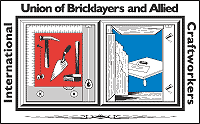International Union of Bricklayers and Allied Craftworkers | |
 | |
| Founded | 1865 |
|---|---|
| Headquarters | Washington, D.C. |
| Location |
|
Members | 74,150 (2018)[1] |
Key people | Timothy J. Driscoll |
| Affiliations | AFL–CIO, CLC, NABTU |
| Website | bacweb |
The International Union of Bricklayers and Allied Craftworkers (BAC) is a labor union in the United States and Canada which represents bricklayers, restoration specialists, pointers/cleaners/caulkers, stonemasons, marble masons, cement masons, plasterers, tile setters, terrazzo mechanics, and tile, marble and terrazzo finishers. The union is an affiliate of the AFL–CIO and its Building and Construction Trades Department. It is also affiliated with the Canadian Labour Congress in Canada.
The oldest continuously operating trade union in North America,[2] BAC was founded in 1865 as the Bricklayers, Masons and Plasterers International Union of America (BMPIU). It was established during a great wave of blue-collar union formation in the 1860s. The organization has changed its name several times during its history to reflect its changing membership. In 1884 the name changed to Bricklayers and Masons International Union. In 1910 the name changed again to Bricklayers, Masons, and Plasterers International Union. In 1995 the union's name changed for the third and final time, renaming the union to International Union of Bricklayers and Allied Craftworkers (BAC). This last change changed "craftsmen" to "craftworkers."
The Union's first Canadian unions were chartered in Hamilton and Toronto, Ontario in 1881, making the union truly international.[3]
BAC President Harry Bates played a major role in the merger of AFL and CIO in 1955,[4] serving as Chair of the Unity Committee.
In 2000, the BAC created its "Canadian Congress" to give Canadian members a powerful, greater voice in union affairs.
James Boland, the 25th President of the International Union, took office in February 2010.
During his tenure the International and its affiliates have focused on creating coalitions with management partners and community groups to expand work prospects for BAC members and signatory contractors. Some of those initiatives include gaining preeminence in green building, strengthening members’ benefits through job-creating capital strategies, and developing customized education and training programs for design professionals, signatory contractors and craftworkers.
YouTube Encyclopedic
-
1/5Views:9 7372 2547351 4201 830
-
Bricklayers and Allied Craftworkers (BAC Local 3)
-
Join the Union: Bricklayers and Allied Craftsmen, Local 1 NY
-
Brick Layers & Allied Craftworkers Local 3 Iowa
-
BAC Partners with IMI and MIT to Build Guastavino Vault Replica
-
Bricklayers Apprenticeship Coordinator
Transcription
Leadership
Executive board
BAC's Executive board is elected every five years by the delegates to the International Union's Convention.
- President: Timothy J. Driscoll
- Secretary-Treasurer: Robert Arnold
- Executive Vice President: Jeremiah Sullivan, Jr. [5]
Presidents
- 1865: John A. White[6]
- 1867: John S. Frost[6]
- 1869: Samuel Gaul[6]
- 1870: John O'Keefe[6]
- 1871: Meredith Moore[6]
- 1872: James T. Kirby[6]
- 1874: Stephen A. Carr[6]
- 1875: Lewis Carpenter[6]
- 1877: Charles H. Rihl[6]
- 1878: Lewis Carpenter[6]
- 1879: Thomas R. Gockel[6]
- 1881: E. J. O'Rourk[6]
- 1882: Henry O. Cole[6]
- 1884: John Pearson[6]
- 1885: Thomas R. Gockel[6]
- 1886: Alex Darragh[6]
- 1890: Alfred J. McDonald[6]
- 1891: John Heartz[6]
- 1894: William Klein[6]
- 1901: George G. Gubbins[6]
- 1904: William J. Bowen[6]
- 1928: George T. Thornton[6]
- 1935: Harry C. Bates[6]
- 1960: John J. Murphy[6]
- 1966: Thomas F. Murphy[6]
- 1979: Jack Joyce[7]
- 1999: John J. Flynn
- 2010: Jim Boland
- 2020: Timothy J. Driscoll
References
- ^ US Department of Labor, Office of Labor-Management Standards. File number 000-034. Report submitted June 10, 2019.
- ^ "Meet Hector Arellano of BAC Administrative District Council I – REJournals". rejournals.com. Retrieved 2022-09-27.
- ^ "BAC Canada". International Union of Bricklayers and Allied Craftworkers. Retrieved 2022-10-05.
- ^ "Welcome New Member Package English 2-5-2020 English 1-10 FIN_0.pdf" (PDF). International Union of Bricklayers and Allied Craftworkers. February 5, 2020. Retrieved October 4, 2022.
- ^ "Leadership". International Union of Bricklayers and Allied Craftworkers. Retrieved 3 May 2021.
- ^ a b c d e f g h i j k l m n o p q r s t u v w x y Notable Names in American History. Clifton, New Jersey: James T. White & Company. 1973. p. 557. ISBN 0883710021.
- ^ "Bricklayers' President Jack Joyce, 77, Pushed for Workers | 2013-03-04 | ENR | Engineering News-Record". www.enr.com.
- Bates, Harry C. Bricklayers' Century of Craftsmanship: A History of the Bricklayers, Masons and Plasterers' International Union of America. Washington, D.C.: Bricklayers, Masons and Plasterers Union, 1955.
- Fink, Gary M., ed. Biographical Dictionary of American Labor. Westport, Conn.: Greenwood Press, 1984. ISBN 0-313-22865-5
- Rayback, Joseph G. A History of American Labor. Rev. and exp. ed. New York: MacMillan Publishing Co., 1974. ISBN 1-299-50529-5
External links
